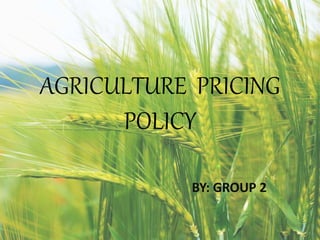
AGRICULTURE PRICING POLICY
- 2. CONTENTS • Trends • Why the need? • APP: what, when, by whom • Importance of price policy • Aim of APP • Instruments • Evaluation: Advantages Disadvantages • Evaluation of agricultural pricing policy • Suggestions for improvement • Current scenario
- 3. TRENDS • With 1952-53 as base, agricultural price index increased from 110 in 1950-51 to 123.8 in 1960-61. • With 1970-71 as base, the index increased from 100.4 in 1971-72 to 236.5 in 1981-82 • With 1993-94 as base, the agricultural price index rose from 116 in 1994-95 to 186.7 in 2004-05
- 4. WHY THE NEED? • Violent fluctuations in price • For providing enough incentive to the farmers for motivating them to use modern and production oriented investment and technology • Severe famines
- 6. AGRICULTURE PRICING POLICY WHAT WHEN BY WHOM
- 7. • Agricultural Prices Commission established in 1968. • Thrust of the policy in 1965:evolve a balanced and an integrated structure to meet the overall needs of the economy. • Headed by professor M.L. Dantwala APP is the tool for influencing the prices of agricultural product. It is an incentive to the producer to produce a particular product according the desired quantity.
- 8. IMPORTANCE OF PRICING POLICY • Agricultural products’ prices fluctuate quicker as compared to industrial goods. • Affects people engaged in other sectors as well. • Also affects the trade of other goods.
- 9. AIM OF APP • To induce the desired output of different crops according to growth targets. • To induce an increase in aggregate agricultural output through large input used and adoption of high yielding seed, fertilizer and water responsive technology. • To induce farmers to part with a large proportion of food grains production as a marketed surplus.
- 10. INSTRUMENTS 1. MINIMUMSUPPORT PRICE • Announced by the government in the beginning of the sowing season • Guarantee price of their produce from the government • Major objectives: support farmers from distress sales procure food grains for public distribution • Government agencies purchase the output at the MSP in case the market price falls below the MSP
- 11. 2.MARKET INTERVENTIONSCHEME • Procurement of perishable and horticultural commodities if market price falls • Implemented when at least 10%increase in production or 10% decrease in the ruling rates over the previous normal year • Procurement made by NAFED(National Agricultural Cooperative Marketing Federation of India limited)
- 12. 3.PUBLICDISTRIBUTION SYSTEM • Important element of Food Security • Management of supplies of essential commodities(wheat,rice,kerosene,sugar) and maintenance of their uninterrupted flow at affordable prices • Beneficiaries: BPL,APL households, Antyodaya Card Holders • Preventing hoarding and black marketing of essential commodities
- 13. 4.PRICE SUPPORT SCHEME • implemented for oil seeds and pulses through NAFED :nodal procurement agency for oilseeds and pulses, apart from Cotton Corporation of India • NAFED purchases oil seeds and pulses from farmers when there prices fall below MSP
- 14. EVALUATION ADVANTAGES 1.Incentive to increase production • The MSP of food grains fixed by the government increase from Rs.388.26 per quintal in 2003-04 to Rs.829.94 in 2012-13 2.Benefit to consumer 3.Benefit to industries • Sugar ,cotton textiles, vegetable oil 4.Price stability
- 15. DISADVANTAGES 1.Inadequate coverage • No benefit to farmers except in case of rice and wheat • Neglected cash crops , pulses and oil seeds 2.Little impact on small and marginal farmers • Marketable surplus comes mainly from big farmers
- 16. 3. Rise in inflation • Pressure from big farmer’s lobby raises procurement prices • Increase in agricultural prices increases the price of other products i.e. Industrial products, services etc 4.Ineffctive PDS • Urban biased and pro rich • Lack of storing space brings financial losses • Corruption and lack of proper knowledge
- 17. EVOLUTION OF APP IN INDIA
- 18. SUGGESTIONS FOR IMPROVEMENT 1.Extention of price policy • Commodities like potato, onion and other important vegetables and fruits may also be covered in addition to the 24 commodities covered at present 2.Improvement in agricultural marketing • Farmers should be set free from middlemen and intermediaries 3.Improvement of PDS • Fair price shops should be made more efficient and transparent; operations streamlined
- 19. CURRENT SCENARIO a)MSPs currently announced for 424 commodities including 7 cereals(paddy, wheat, barley, jowar, bajra, maize and ragi );5 pulses( gram, arhar / tur, moong , urad and lentil);8 oil seeds(ground nut, rape seed , mustard , toria , soya bean , sunflower seed , sesamum , safflower seed , niger seed);copra raw cotton raw jute and virginia flu cured(VFC) tobacco. b)Inflation in food-around 8%p.a.,fruit and vegetable inflation-16% • Since a large part of food inflation in recent years has been on account of high fruit and vegetable inflation ,this may continue to be a cause for concern. It’s more so because of the untimely rain.
- 20. c)Prices of cash crops such as wheat lower by 2%compared with prices last year. on a y-o- y(year on year) basis , most cash crop have seen a sharp fall in prices in domestic market: tea(-8%),cotton(-28%),safflower(- 20%), soyabean (-13%),guar(- 16%),rubber(-15%) d)Minimum Support Price
- 21. COMMODI TY VARIETY MSP2014- 15(RS PER QUINTAL) MSP 2015- 16(RS PER QUINTAL) INCREASE OVER PRIVIOUS YEAR(RS PER QUINTAL) KHARIF CROPS Paddy common 1360 1410 50 Grade ’A’ 1400 1450 50 Bajra 1250 1275 25 Maize 1310 1325 15 Ragi 1550 1650 100 Cotton Medium staple 3750 3800 50 Long staple 4050 4100 50 Arhar(tur) 4350 4625(inclu de Rs 200 bonus) 275 Moong 4600 4850(inclu de Rs200 bonus) 250
- 22. COMMODITY VARIETY MSP2014- 15(Rs PER QUINTAL) MSP2015- 16(RsPER QUINTAL) INCREASE OVER PREVIOUS YEAR(Rs PER QUINTAL) RABI CROPS(To be marketed in 2016-17) Wheat 1450 1525 75 Barley 1150 1225 75 Gram 3175 3425 250 Masur 3075 3325 250 Mustard 3100 3350 250 Safflower 3050 3300 250